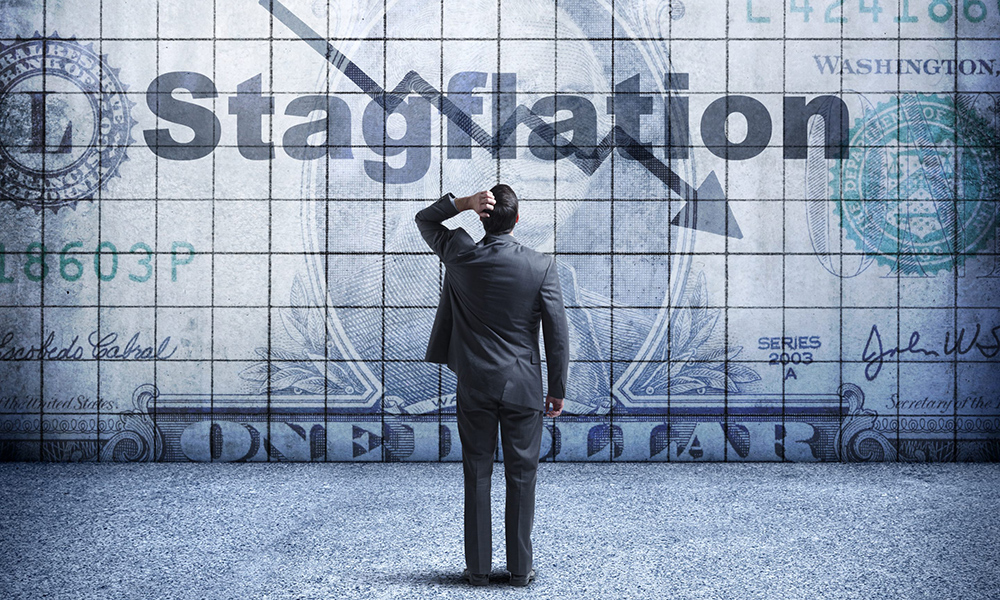随着对滞胀的担忧影响股市,华尔街应该引起重视

近期数据显示,美国经济增长急剧放缓,通胀加剧,这导致担心滞胀的声音一直不绝于耳。
现在,华尔街无法忽视这个令人不愿触及的问题,因为它已经开始影响金融市场,尤其是债券市场。
索斯尼科补充道:“如果经济疲软但却无法降低通胀,你会不由自主地想到滞胀这个词。所以在GDP表现远不及预期的时候,债券收益率大涨,才会令人感到震惊。因此,肯定是对通货膨胀的担忧引发了这种状况。”
分析师认为最近的数据“在两方面都是最糟糕的”,因为顽固的通货膨胀依旧高于美联储2%的目标,这会阻止美联储降息。历史上,美联储曾经选择以降息来应对经济增长疲软。
由于市场预期美联储将被迫在更长时间内延续其紧缩货币政策,10年期美国国债收益率近几天重新上涨至4.7%,之后有所回落,但市场担心它最终可能回升至5%。
债券收益率上涨会影响抵押贷款利率等其他借款成本,而且影响到了股市,尤其是英伟达(Nvidia)等以增长为导向的科技股。
索斯尼科警告称,投资者应该感到“有些担心”,他认为在市场整体反弹时可以随便选择投资对象的时代已经结束。
他补充道:“股票和债券之间的拉锯战令人变得神经紧张。”
他解释称,今年早些时候,市场忽视了这种动态,因为股市持续出现“令人担心错过的”反弹行情,而债券收益率上升被归因于强劲的经济,这在一定程度上对股市是利好消息。
但随着经济降温和通胀再次升高,现在债券市场开始感到压力。索斯尼科警告称,由于美联储将在下周开会并发布月度就业报告,因此,股市依旧存在巨大的下行风险。他指出,尽管股市下跌了4%至5%,但并没有完成一轮回调,因为一轮回调的跌幅通常为10%。
其他华尔街分析师也对数据所预示的滞胀情景感到不安。
周二,摩根大通(JPMorgan)CEO杰米·戴蒙表示,当前的经济状况更像是20世纪70年代,当时通胀和失业率都很高,但经济增长疲软。
他还暗示,2024年的有些指标可能比1970年更糟糕。他表示:“在20世纪70年代,赤字只有今天的一半,债务占GDP的比率为35%而不是100%,因此我认为当前经济增长强劲的部分原因是财政支出。”
同样在本周,瑞银(UBS)全球财富管理投资主管马克·海菲勒对MarketWatch表示,他担心的并非某一个数据点,而是“没有人真正做好准备”迎接滞胀。(财富中文网)
翻译:刘进龙
审校:汪皓
近期数据显示,美国经济增长急剧放缓,通胀加剧,这导致担心滞胀的声音一直不绝于耳。
现在,华尔街无法忽视这个令人不愿触及的问题,因为它已经开始影响金融市场,尤其是债券市场。
索斯尼科补充道:“如果经济疲软但却无法降低通胀,你会不由自主地想到滞胀这个词。所以在GDP表现远不及预期的时候,债券收益率大涨,才会令人感到震惊。因此,肯定是对通货膨胀的担忧引发了这种状况。”
分析师认为最近的数据“在两方面都是最糟糕的”,因为顽固的通货膨胀依旧高于美联储2%的目标,这会阻止美联储降息。历史上,美联储曾经选择以降息来应对经济增长疲软。
由于市场预期美联储将被迫在更长时间内延续其紧缩货币政策,10年期美国国债收益率近几天重新上涨至4.7%,之后有所回落,但市场担心它最终可能回升至5%。
债券收益率上涨会影响抵押贷款利率等其他借款成本,而且影响到了股市,尤其是英伟达(Nvidia)等以增长为导向的科技股。
索斯尼科警告称,投资者应该感到“有些担心”,他认为在市场整体反弹时可以随便选择投资对象的时代已经结束。
他补充道:“股票和债券之间的拉锯战令人变得神经紧张。”
他解释称,今年早些时候,市场忽视了这种动态,因为股市持续出现“令人担心错过的”反弹行情,而债券收益率上升被归因于强劲的经济,这在一定程度上对股市是利好消息。
但随着经济降温和通胀再次升高,现在债券市场开始感到压力。索斯尼科警告称,由于美联储将在下周开会并发布月度就业报告,因此,股市依旧存在巨大的下行风险。他指出,尽管股市下跌了4%至5%,但并没有完成一轮回调,因为一轮回调的跌幅通常为10%。
其他华尔街分析师也对数据所预示的滞胀情景感到不安。
周二,摩根大通(JPMorgan)CEO杰米·戴蒙表示,当前的经济状况更像是20世纪70年代,当时通胀和失业率都很高,但经济增长疲软。
他还暗示,2024年的有些指标可能比1970年更糟糕。他表示:“在20世纪70年代,赤字只有今天的一半,债务占GDP的比率为35%而不是100%,因此我认为当前经济增长强劲的部分原因是财政支出。”
同样在本周,瑞银(UBS)全球财富管理投资主管马克·海菲勒对MarketWatch表示,他担心的并非某一个数据点,而是“没有人真正做好准备”迎接滞胀。(财富中文网)
翻译:刘进龙
审校:汪皓
There’s been a steady drumbeat of concerns about stagflation as recent data showed economic growth slowing sharply and inflation picking up.
Now, Wall Street can’t ignore that unpleasant subject as its presence is starting to be felt on financial markets, especially in bonds.
“Well, if you have a weak economy and inflation that’s not coming down, you kind of have to think in those terms,” Sosnick added. “And that’s why it was kind of shocking to see bond yields rise on a day where GDP was a big miss. So it has to be that other inflation nervousness.”
Analysts have called the latest batch of data “the worst of both worlds” as inflation that stubbornly remains above the Federal Reserve’s 2% target will prevent it from cutting rates, which it historically has done in response to softening economic growth.
Expectations that the Fed will be forced to continue its tight monetary policy for longer has sent the 10-year Treasury yield surging back to 4.7% in recent days before retreating, though markets are concerned an eventual return to 5% is possible.
The resurgence in bond yields, which affects other borrowing costs like mortgage rates, has also hit stocks, especially growth-oriented tech giants like Nvidia.
Investors should feel “concerned, a little bit,” Sosnick cautioned, saying that the time to buy anything amid a broad market rally has ended.
“The push-pull between stocks and bonds is getting a little nerve racking,” he added.
Markets ignored that dynamic earlier in the year as a relentless “fear of missing out” stock rally was ongoing, while the uptick in bond yields had been attributed to a strong economy, which can help stocks—up to a certain point, he explained.
But with growth cooling off and inflation ramping up again, now the bond market is starting to get stressed. And as a Fed meeting and monthly job reports are due in the coming week, the downside risk in stocks remains substantial, Sosnick warned, pointing out that the market fell 4%-5% but didn’t complete a correction, which typically is considered a 10% drop.
Others on Wall Street have also voiced uneasiness with the data trending toward a stagflation scenario.
On Tuesday, JPMorgan CEO Jamie Dimon said now more so than ever the economy is resembling the 1970s, when both inflation and unemployment were high but economic growth was weak.
He also hinted that some indicators may be worse in 2024 than they were in 1970, saying, “If you go back to the ’70s, deficits were half of what they are today, the debt to GDP was 35%, not 100%, and so part of the reason I think we’ve had this strong growth is the fiscal spending.”
Also this week, UBS global wealth management investment head Mark Haefele told MarketWatch that he’s not worried about one data point, “nobody’s really prepared” for stagflation.













